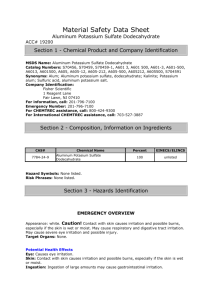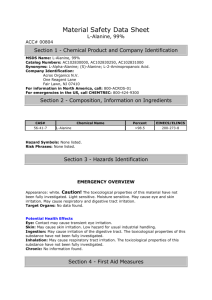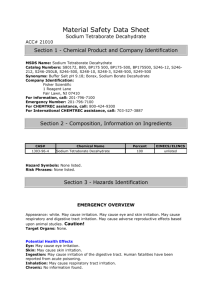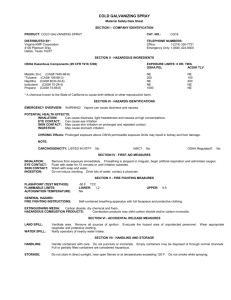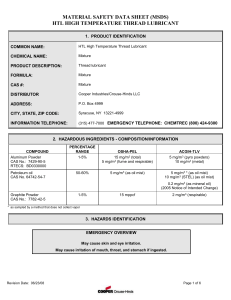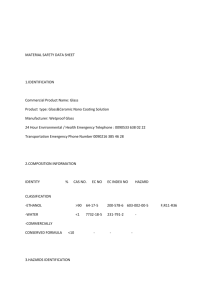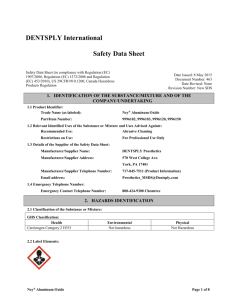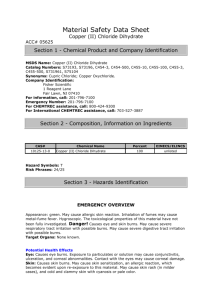Material Safety Data Sheet Aluminum (Metallic, Powder) ACC
advertisement
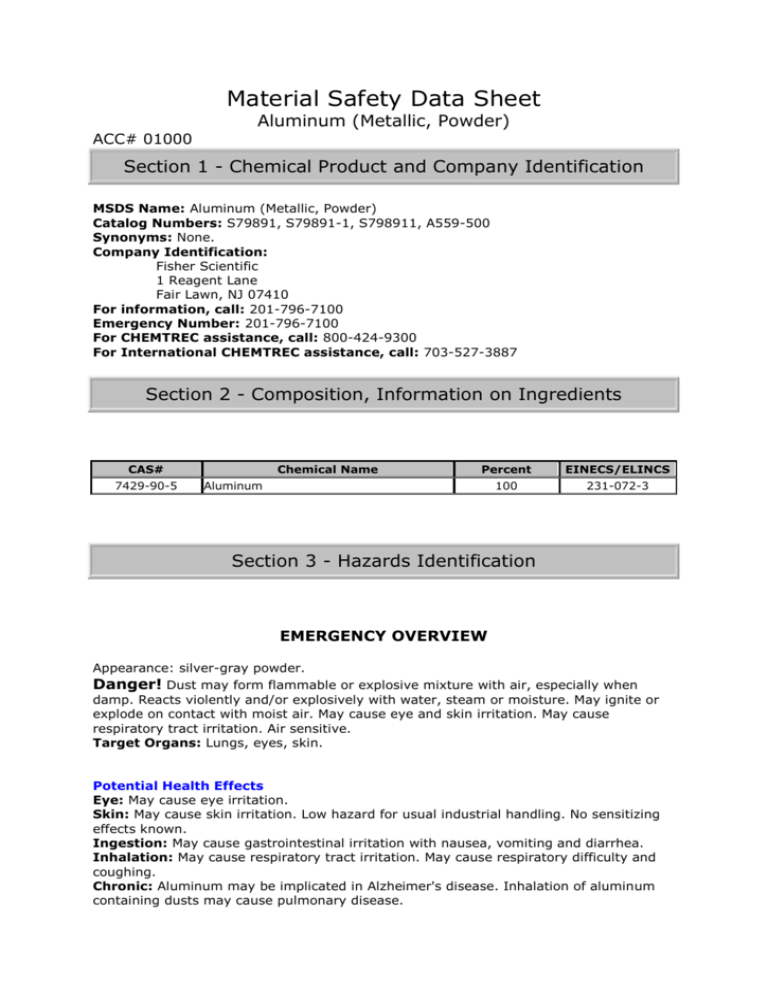
Material Safety Data Sheet Aluminum (Metallic, Powder) ACC# 01000 Section 1 - Chemical Product and Company Identification MSDS Name: Aluminum (Metallic, Powder) Catalog Numbers: S79891, S79891-1, S798911, A559-500 Synonyms: None. Company Identification: Fisher Scientific 1 Reagent Lane Fair Lawn, NJ 07410 For information, call: 201-796-7100 Emergency Number: 201-796-7100 For CHEMTREC assistance, call: 800-424-9300 For International CHEMTREC assistance, call: 703-527-3887 Section 2 - Composition, Information on Ingredients CAS# 7429-90-5 Chemical Name Percent EINECS/ELINCS 100 231-072-3 Aluminum Section 3 - Hazards Identification EMERGENCY OVERVIEW Appearance: silver-gray powder. Danger! Dust may form flammable or explosive mixture with air, especially when damp. Reacts violently and/or explosively with water, steam or moisture. May ignite or explode on contact with moist air. May cause eye and skin irritation. May cause respiratory tract irritation. Air sensitive. Target Organs: Lungs, eyes, skin. Potential Health Effects Eye: May cause eye irritation. Skin: May cause skin irritation. Low hazard for usual industrial handling. No sensitizing effects known. Ingestion: May cause gastrointestinal irritation with nausea, vomiting and diarrhea. Inhalation: May cause respiratory tract irritation. May cause respiratory difficulty and coughing. Chronic: Aluminum may be implicated in Alzheimer's disease. Inhalation of aluminum containing dusts may cause pulmonary disease. Section 4 - First Aid Measures Eyes: In case of contact, immediately flush eyes with plenty of water for a t least 15 minutes. Get medical aid. Skin: In case of contact, flush skin with plenty of water. Remove contaminated clothing and shoes. Get medical aid if irritation develops and persists. Wash clothing before reuse. Ingestion: If swallowed, do not induce vomiting unless directed to do so by medical personnel. Never give anything by mouth to an unconscious person. Get medical aid. Inhalation: If inhaled, remove to fresh air. If not breathing, give artificial respiration. If breathing is difficult, give oxygen. Get medical aid. Notes to Physician: Treat symptomatically and supportively. Section 5 - Fire Fighting Measures General Information: As in any fire, wear a self-contained breathing apparatus in pressure-demand, MSHA/NIOSH (approved or equivalent), and full protective gear. Water reactive. Material will react with water and may release a flammable and/or toxic gas. Dust can be an explosion hazard when exposed to heat or flame. May ignite or explode on contact with steam or moist air. Aluminum powder may evolve hydrogen gas in contact with water and finely divided dust may be ignited by naked lights or sparks. Polished aluminum powders which have been treated with oils or wax for printing or paint purposes are not generally dangerous. Bulk dust when damp with water may heat spontaneously. Hazard greater as fineness increases. Extinguishing Media: DO NOT USE WATER! Do NOT get water inside containers. Contact professional fire-fighters immediately. Do NOT use CO2 or halogenated extinguishing agents. Smother with dry sand, dry clay, dry ground limestone (CaCO3), or use approved Class D extinguishers. Flash Point: Not applicable. Autoignition Temperature: 760 deg C ( 1,400.00 deg F) Explosion Limits, Lower:Not available. Upper: Not available. NFPA Rating: (estimated) Health: 0; Flammability: 3; Instability: 1; Special Hazard: W- Section 6 - Accidental Release Measures General Information: Use proper personal protective equipment as indicated in Section 8. Spills/Leaks: Clean up spills immediately, observing precautions in the Protective Equipment section. Avoid generating dusty conditions. Remove all sources of ignition. Use a spark-proof tool. Provide ventilation. Do not expose spill to water. Vacuum or sweep up material and place into a suitable, dry disposal container. Section 7 - Handling and Storage Handling: Wash thoroughly after handling. Remove contaminated clothing and wash before reuse. Do not allow water to get into the container because of violent reaction. Minimize dust generation and accumulation. Avoid contact with skin and eyes. Avoid ingestion and inhalation. Do not allow contact with water. Keep from contact with moist air and steam. Use only with adequate ventilation. Storage: Keep away from sources of ignition. Store in a cool, dry, well-ventilated area away from incompatible substances. Keep away from water. Flammables-area. Keep containers tightly closed. Keep away from acidic, alkaline, combustible and oxidizing materials. Separate from halogenated compounds. Section 8 - Exposure Controls, Personal Protection Engineering Controls: Use explosion-proof ventilation equipment. Facilities storing or utilizing this material should be equipped with an eyewash facility and a safety shower. Use adequate general or local exhaust ventilation to keep airborne concentrations below the permissible exposure limits. Exposure Limits Chemical Name Aluminum ACGIH 10 mg/m3 TWA (metal dust) NIOSH OSHA - Final PELs 10 mg/m3 TWA (total dust); 5 mg/m3 TWA (respirable dust) 15 mg/m3 TWA (total dust); 5 mg/m3 TWA (respirable fraction) OSHA Vacated PELs: Aluminum: 15 mg/m3 TWA (total dust); 5 mg/m3 TWA (respirable fraction) Personal Protective Equipment Eyes: Wear appropriate protective eyeglasses or chemical safety goggles as described by OSHA's eye and face protection regulations in 29 CFR 1910.133 or European Standard EN166. Skin: Wear appropriate protective gloves to prevent skin exposure. Clothing: Wear appropriate protective clothing to prevent skin exposure. Respirators: A respiratory protection program that meets OSHA's 29 CFR 1910.134 and ANSI Z88.2 requirements or European Standard EN 149 must be followed whenever workplace conditions warrant respirator use. Section 9 - Physical and Chemical Properties Physical State: Powder Appearance: silver-gray Odor: odorless pH: Not available. Vapor Pressure: Negligible Vapor Density: Not available. Evaporation Rate:Not available. Viscosity: Not available. Boiling Point: 2467 deg C @ 760 mmHg Freezing/Melting Point:660 deg C Decomposition Temperature:> 2400 deg C Solubility: insoluble Specific Gravity/Density:2.7020g/cm3 Molecular Formula:Al Molecular Weight:26.98 Section 10 - Stability and Reactivity Chemical Stability: Stable under normal temperatures and pressures. Aluminum powder may evolve hydrogen gas in contact with water, and finely divided dust may be ignited by naked lights or sparks. Polished aluminum powders which have been treated with oils or wax for printing or paint purposes are not generally dangerous Uncoated aluminum powder reacts with strong acid and strong alkalies to release hydrogen gas. Conditions to Avoid: Ignition sources, dust generation, exposure to air, excess heat, exposure to moist air or water. Incompatibilities with Other Materials: Acids, alkalies, acid chlorides, halogenated agents, metal salts, strong oxidizing agents, Contact with water liberates highly flammable gases., ammonium nitrate, ammonium persulfate, antimony, arsenic oxides, barium bromate, barium chlorate, barium iodate. Hazardous Decomposition Products: Hydrogen gas, aluminum oxide, aluminum fumes. Hazardous Polymerization: Has not been reported Section 11 - Toxicological Information RTECS#: CAS# 7429-90-5: BD0330000; BD1020000 LD50/LC50: Not available. Carcinogenicity: CAS# 7429-90-5: Not listed by ACGIH, IARC, NTP, or CA Prop 65. Epidemiology: No information available. Teratogenicity: No information available. Reproductive Effects: No information available. Mutagenicity: No information available. Neurotoxicity: Chronic exposure to aluminum has produced numbness in fingers and (in one case) brain effects. Other Studies: Section 12 - Ecological Information No information available. Section 13 - Disposal Considerations Chemical waste generators must determine whether a discarded chemical is classified as a hazardous waste. US EPA guidelines for the classification determination are listed in 40 CFR Parts 261.3. Additionally, waste generators must consult state and local hazardous waste regulations to ensure complete and accurate classification. RCRA P-Series: None listed. RCRA U-Series: None listed. Section 14 - Transport Information Shipping Name: US DOT Canada TDG ALUMINUM POWDER, UNCOATED ALUMINUM POWDER, UNCOATED Hazard Class: 4.3 4.3 UN Number: UN1396 UN1396 Packing Group: II II Section 15 - Regulatory Information US FEDERAL TSCA CAS# 7429-90-5 is listed on the TSCA inventory. Health & Safety Reporting List None of the chemicals are on the Health & Safety Reporting List. Chemical Test Rules None of the chemicals in this product are under a Chemical Test Rule. Section 12b None of the chemicals are listed under TSCA Section 12b. TSCA Significant New Use Rule None of the chemicals in this material have a SNUR under TSCA. CERCLA Hazardous Substances and corresponding RQs None of the chemicals in this material have an RQ. SARA Section 302 Extremely Hazardous Substances None of the chemicals in this product have a TPQ. SARA Codes CAS # 7429-90-5: immediate, delayed. Section 313 This material contains Aluminum (CAS# 7429-90-5, 100%),which is subject to the reporting requirements of Section 313 of SARA Title III and 40 CFR Part 373. Clean Air Act: This material does not contain any hazardous air pollutants. This material does not contain any Class 1 Ozone depletors. This material does not contain any Class 2 Ozone depletors. Clean Water Act: None of the chemicals in this product are listed as Hazardous Substances under the CWA. None of the chemicals in this product are listed as Priority Pollutants under the CWA. None of the chemicals in this product are listed as Toxic Pollutants under the CWA. OSHA: None of the chemicals in this product are considered highly hazardous by OSHA. STATE CAS# 7429-90-5 can be found on the following state right to know lists: California, New Jersey, Pennsylvania, Minnesota, Massachusetts. California Prop 65 California No Significant Risk Level: None of the chemicals in this product are listed. European/International Regulations European Labeling in Accordance with EC Directives Hazard Symbols: F Risk Phrases: R 15 Contact with water liberates extremely flammable gases. R 17 Spontaneously flammable in air. Safety Phrases: S 7/8 Keep container tightly closed and dry. S 43A In case of fire, use dry chemical (never use water). WGK (Water Danger/Protection) CAS# 7429-90-5: 0 Canada - DSL/NDSL CAS# 7429-90-5 is listed on Canada's DSL List. Canada - WHMIS This product has a WHMIS classification of B6, D2B. This product has been classified in accordance with the hazard criteria of the Controlled Products Regulations and the MSDS contains all of the information required by those regulations. Canadian Ingredient Disclosure List CAS# 7429-90-5 is listed on the Canadian Ingredient Disclosure List. Section 16 - Additional Information MSDS Creation Date: 6/25/1999 Revision #6 Date: 6/06/2006 The information above is believed to be accurate and represents the best information currently available to us. However, we make no warranty of merchantability or any other warranty, express or implied, with respect to such information, and we assume no liability resulting from its use. Users should make their own investigations to determine the suitability of the information for their particular purposes. In no event shall Fisher be liable for any claims, losses, or damages of any third party or for lost profits or any special, indirect, incidental, consequential or exemplary damages, howsoever arising, even if Fisher has been advised of the possibility of such damages.
